
What Is Lion's Mane Mushroom?
Despite growing all over the Northern Hemisphere, lion's mane mushrooms have been relatively unknown outside of Asia until recently. Now, people in the West are catching up several thousands of years late to what our friends in the East have known for quite a while.
Mushrooms—they’ve been around for hundreds of millions of years, but only now are they truly getting the attention they deserve. You know, humans and mushrooms share a common ancestor, so it’s about time we gave a little more positive attention to our fungal brethren. Whether you want to delight your palate or expand your consciousness, mushrooms can provide. Is there anything else quite as versatile as fungi?
However, though we in the West have neglected these strange little beings, not everyone has. In the East, mushrooms have been used for thousands of years in traditional practices—and those practices still continue to this day. But only recently have they found their way into the Western mainstream. Enter the lion’s mane mushroom.
What Is Lion's Mane (Hericium erinaceus)?
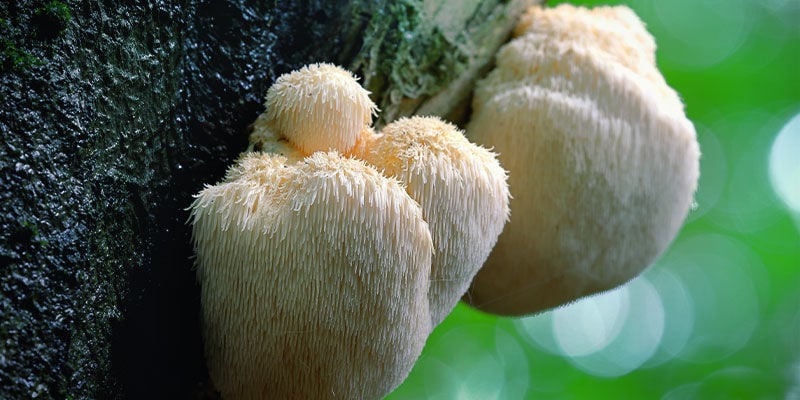
The lion’s mane mushroom is an alien-looking fungus that goes by many names: monkey head mushroom, bearded tooth mushroom, satyr's beard, bearded hedgehog mushroom, pom pom mushroom, or bearded tooth fungus. In Latin, it is known as Hericium erinaceus. Erinaceus actually means hedgehog in Latin, referring to the mushroom’s many spines. The lion’s mane mushroom grows in a tight clump of thin, spore-producing spines that dangle downward.
Found throughout the Northern Hemisphere in North America, Europe, and Asia, Hericium erinaceus has been used for thousands of years in traditional holistic practices. Thought to clear the mind and enhance cognition, Buddhist monks once used lion’s mane-infused tea to improve their meditative practices.
These days, lion's mane is used across the world as a wellness supplement, but due to a lack of research, it’s exact benefits and effects are not yet known. What we do know, though, is that it contains all the essential amino acids—except for methionine and tryptophan—the human body requires, so this fungus could serve as a superfood.
Where and How Does Lion's Mane Grow?
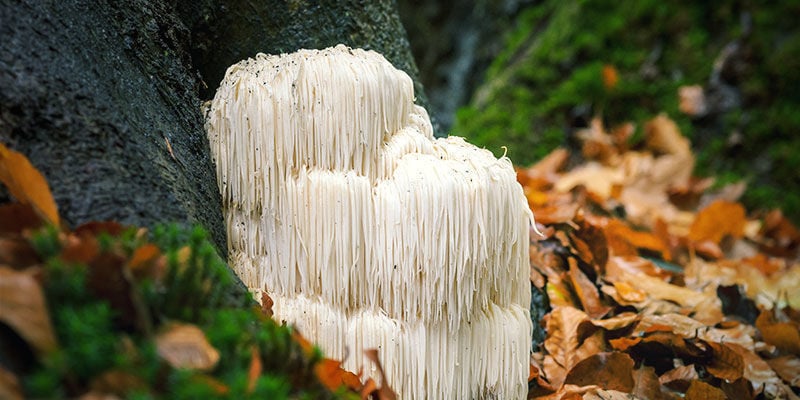
This fungus is widespread across the northern world. On the whole, lion’s mane is found most readily on hardwood trees. It predominantly grows on dead trees, though it can be found on live ones too.
It has been said that lion’s mane can live for up to forty years, fruiting intermittently throughout that time. When it’s not fruiting, no body will be visible, but you can be sure the mycelium is alive beneath the wood’s surface. When it fruits, it does so toward the end of summer. However, the spores are released in winter, up until February. Unlike some other mushroom species, Hericium erinaceus bodies can survive cold and frost.
What Does Lion's Mane Look Like?
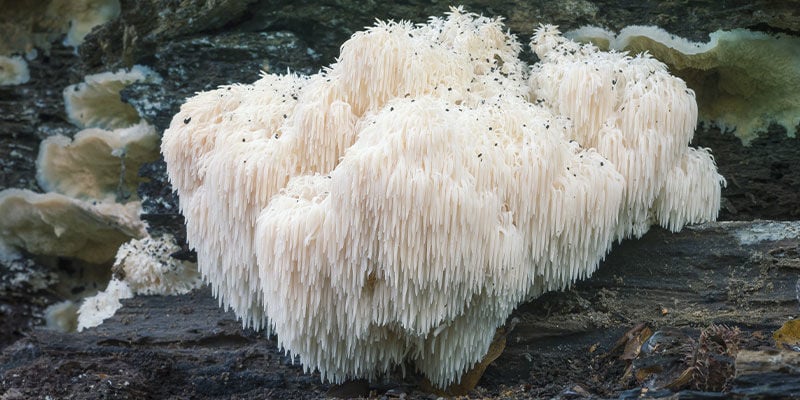
They look, well, a bit like a lion’s mane. They are a mass of shaggy-looking white spines that hang down in a mess—sort of like Boris Johnson’s hair. Depending on various factors like specific habitat and infested tree species, these spines tend to grow to around 1–7cm long and 1.5–2mm thick, and it is from these that the spores are released for reproductive purposes. Whether you find them beautiful or a bit too alien is perhaps a matter of taste. But what cannot be denied is that they are most certainly impressive little things.
Is Lion's Mane an Adaptogen?
A note on adaptogens—according to the European Medicines Agency, adaptogens are not a thing. Though there is some research into adaptogens’ supposed ability to improve cognitive well-being and aid homeostasis, it has been methodologically poor and therefore deemed untrustworthy.
However, for those who do believe in adaptogens, lion’s mane mushrooms are often classed among them.
Reasons To Use Lion's Mane
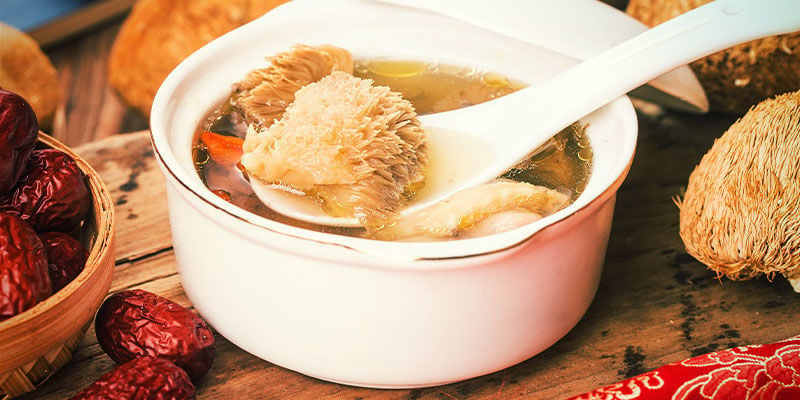
There are a couple of good reasons to use lion’s mane. For some, traditional practices are worth continuing, and they may want to use them for this purpose. After all, if it’s good enough for the Buddhist monks of old, surely it’s good enough for us too?
Another reason to use them is that they are delicious. Along with the likes of shiitake, lion’s mane is a gourmet ingredient used in Eastern cooking. It is cited as having a flavour rather like lobster or aubergine. So, if nothing else, it’s certainly a delicious culinary treat.
What Forms of Lion's Mane Are Available?
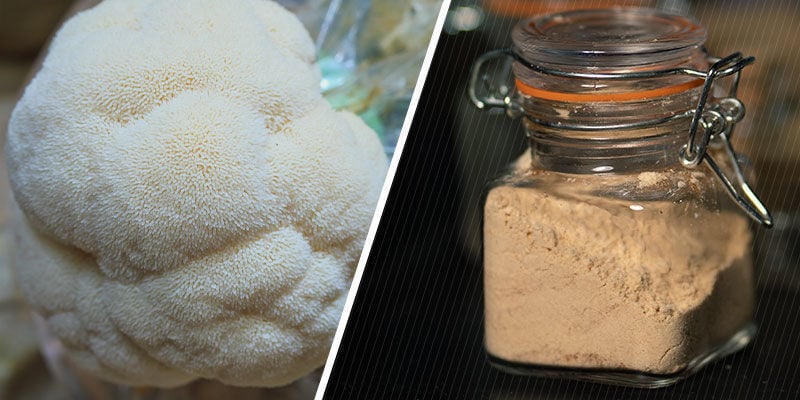
If you want to get your hands on lion’s mane mushrooms, you’re not limited to fresh ones—although, if you’re after them for culinary purposes, they may be more desirable in this form than a dehydrated extract!
Whole Mushrooms
You can get lion’s mane mushrooms whole, either fresh or dried. Fresh mushrooms are the most suitable for cooking but will have to be consumed very quickly. Dried ones are more versatile; they can be made into tea, ground up, or potentially rehydrated.
Powder
Powdered lion’s mane is now very common. It comes either simply in a powdered form, or as an extract. The advantage of the extract is that it can be highly concentrated, meaning it can be up to 30 times stronger than the equivalent amount of fresh lion’s mane.
Capsules
If you want a method of ingestion that is easy to work into a busy daily routine, then Lion's Mane capsules are the perfect option. Containing predetermined doses of powdered Lion's Mane mushroom, they have all the same gains as that method, with even more simplicity. Simply swallow them with a drink and continue with your day! This is a method for those who are busy but want a little traditional goodness in their lives.
Tincture
Lion’s mane mushroom tinctures are also available. These are extracts also, but extracts made into oil, rather than powder. These can simply be dropped under your tongue, onto food, or into tea.
Effects and Side Effects of Lion's Mane
Much of what we think about lion’s mane has been passed down to us through traditional practice. The scientific information on it is currently fairly limited, although it is growing.
What Are the Benefits of Lion's Mane?
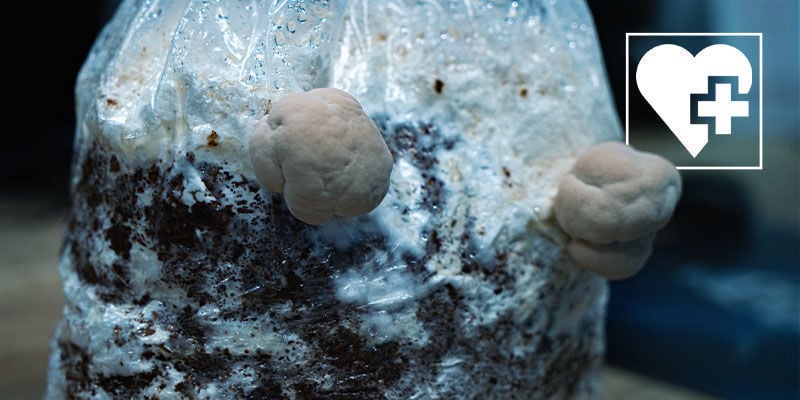
There are a number of compounds found in lion’s mane that may benefit the body to some degree.
-
Hericenones
These are found in the fruiting bodies of lion’s mane. They are also found in many other things. In studies on mice, hericenones have been demonstrated to exhibit a strong stimulatory effect on the biosynthesis of nerve growth factor (NGF).
But what is nerve growth factor? NGF is involved in the growth, proliferation, maintenance, and survival of neurons. It also has functions in the immune system, related to inflammation and pain perception. Another interesting fact; NGF has been found in higher concentrations in the blood plasma of individuals who have been in a romantic relationship for less than 12 months compared to those who have been in one longer.
-
Erinacines
As far as we know, erinacines are found most abundantly within the mycelium of lion’s mane. Both in and out of mushrooms, there are 15 that have been identified. Of these 15, several have powerful effects on NGF (erinacines A, B, C, E, F, H, and I). Some suggest that the effects are stronger than hericenones.
-
Polysaccharides
Lion’s mane mushrooms are a great source of polysaccharides. This is a broad term for nature’s most abundant carbohydrate. Polysaccharides are chains of 10 or more monosaccharides. A few examples of monosaccharides are glucose, fructose, and glyceraldehyde. But there are many more. In bodies, both animal, plant, and fungal, they are used for structure and storage—depending on what is present in the chain. It is possible that the polysaccharides in lion’s mane mushrooms have an unusual chain.
In mushrooms, polysaccharides are commonly found in chitin, which makes up their cell walls. In animals and plants, the cell walls are made of cellulose, which is thought to be the most abundant organic compound on earth.
What Are Potential Side Effects of Lion's Mane?
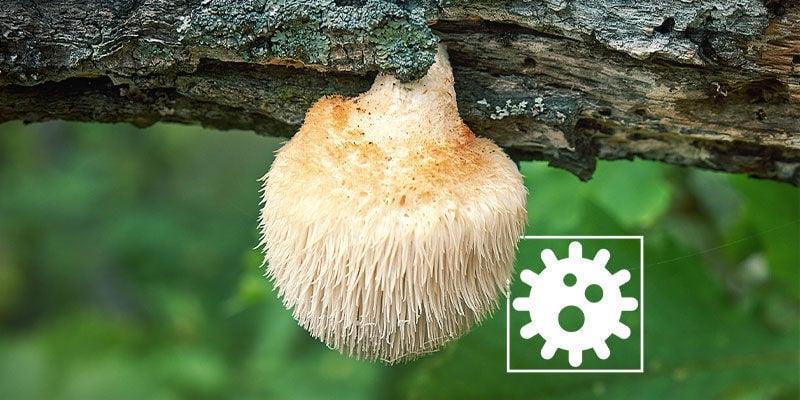
Side effects of lion’s mane seem to be minimal and very rare. In fact, how little we know about the fungus is likely evidence that it is rarely, if ever, deemed severe enough to report or record.
That being said, some suggest that lion’s mane could antagonise allergies such as asthma.
Is Lion's Mane Mushroom Safe To Use?
Yes. As far as we know, there are no reports of any serious adverse effects resulting from ingesting lion’s mane. And although it is little known in the Western world, in Asia it has been used in holistic and culinary practice for an incredibly long time. It is, at its core, another edible mushroom.
Can Lion's Mane Get You High?
No. As it does not contain any psychoactive compounds (e.g. psilocybin or psilocin), it cannot cause a psychedelic experience. But that doesn’t mean it’s not worth eating!
Is Lion's Mane a Nootropic?
Nootropics are substances believed to boost cognitive function. Often used by professionals and creatives, nootropics have become increasingly popular in recent years. In terms of lion’s mane, some claim that yes, the fungus exhibits nootropic-like effects.
How To Use Lion's Mane
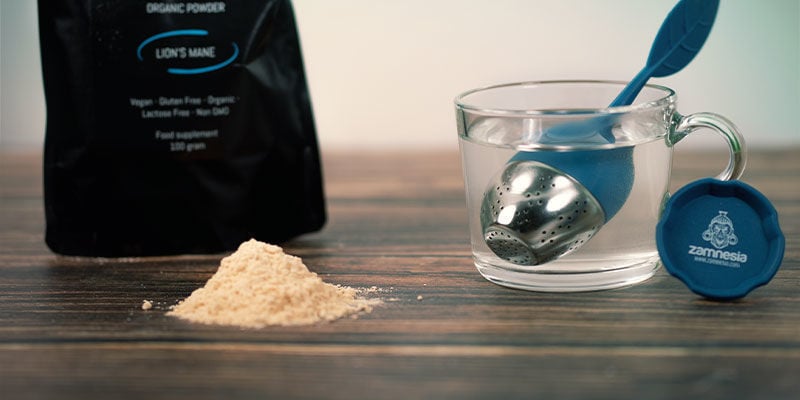
You can use lion’s mane in a number of ways. If you like cooking and experimenting with unusual ingredients, then get yourself a fresh specimen. Used as a gourmet ingredient in cooking, it boasts an unusual yet delicious flavour. Otherwise, you can treat yourself to a warming tea using a lion's mane extract.
However you choose to take it, it’s safe to take with a variety of other things. Indeed, “super mixes” of numerous mushrooms are available. These often combine the likes of reishi, cordyceps, chaga, shiitake, and more. It is also safe to take alongside CBD, in whichever form you choose to do so.
How Much Lion's Mane Should You Take?
This depends on how you’re taking it. Some methods involve the fresh mushroom, while others are concentrated extracts. When taking extracts, the dosage will be much lower.
Dosage
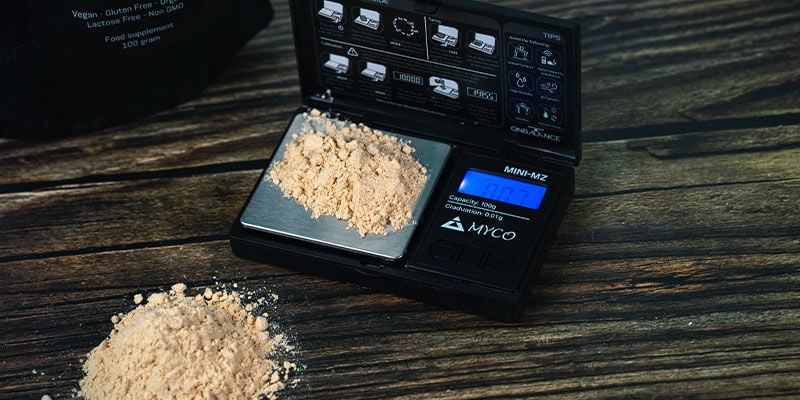
-
Capsules: 1–3 capsules a day taken with food.
-
Powder: 2–4 grams a day. Some suggest that you take 4 grams for the first few weeks, and then reduce it to 2 grams a day from then on.
-
Dried Mushroom: The same as the powder. Up to 4 grams a day should suffice.
-
Fresh Mushroom: In this instance, you’re likely to be using it in cooking. Therefore, use as much or as little as you need. You won’t be doing any harm by taking more than is suggested. Plus, mushrooms can decrease in weight by as much as 90% when dehydrated; 5 grams dry could equal 50 grams fresh!
How Long Does It Take for Lion's Mane To Work?
It is recommended to take lion’s mane for a few weeks before expecting anything from it.
When Is the Best Time To Take Lion's Mane
This is up for discussion. As it’s taken over a long period, rather than for immediate, short-lived effects, the most important thing is to take it regularly. So work it into your routine, and take it at consistent intervals to form a habit.
How To Store Lion's Mane Mushrooms
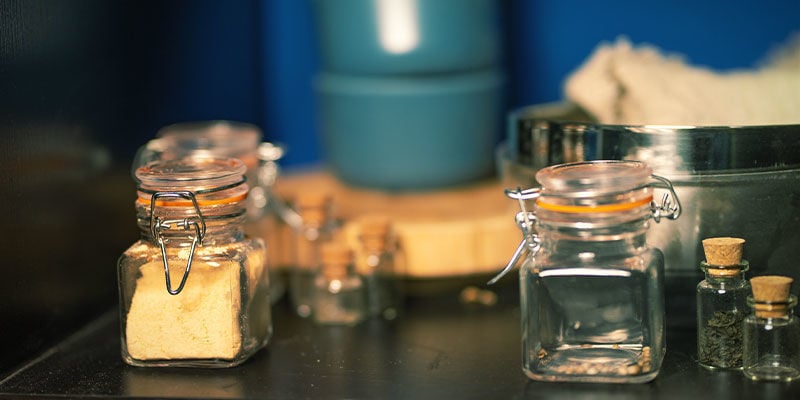
Most will know that fresh mushrooms can get soggy pretty quickly. So if you’re using fresh lion’s mane mushrooms, keep them stored in a fridge and use them within a couple of days.
Otherwise, all the other forms should last indefinitely so long as they’re stored in a cool, dry place in appropriate packaging.
Lion’s Mane: Does It Live Up to Its Epic Name?
Yes, if you like mushrooms. While we cannot say exactly what benefits they may or may not have on one’s health, many individuals regularly take lion’s mane and swear by its effects. And what we can say is that the mushrooms taste great. So whether you want to try them out in honour of the ancients, or just experiment in the kitchen, we’d advise getting your hands on some lion’s mane!
- (n.d.). Tetrahedron Letters | Vol 32, Issue 35, Pages 4409-4604 (1991) | ScienceDirect.com by Elsevier - https://www.sciencedirect.com
- (2006/04/01). Raised plasma nerve growth factor levels associated with early-stage romantic love - https://www.sciencedirect.com
- (1994/03/07). Erinacines A, B and C, strong stimulators of nerve growth factor (NGF)-synthesis, from the mycelia of Hericium erinaceum - https://www.sciencedirect.com
-
 3 min
26 June 2023
Using Magic Mushrooms For Studying: Does It Help?
When exam period approaches, it can be tempting to turn to drugs to assist us in our studies. But how can you use them in a way that actually helps? In this article, we delve into the topic of...
3 min
26 June 2023
Using Magic Mushrooms For Studying: Does It Help?
When exam period approaches, it can be tempting to turn to drugs to assist us in our studies. But how can you use them in a way that actually helps? In this article, we delve into the topic of...
-
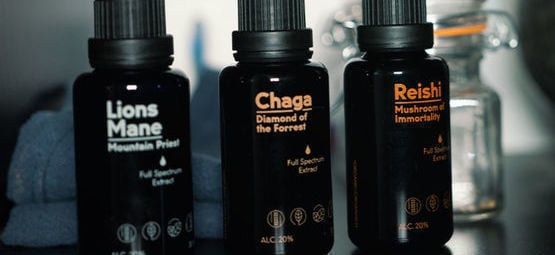 9 min
14 April 2022
Information About Mushroom Tinctures
Looking to discover the potential benefits that mushroom tinctures have to offer? Thinking of making a purchase, but a little unsure of where to start? You're certainly not alone; mushroom...
9 min
14 April 2022
Information About Mushroom Tinctures
Looking to discover the potential benefits that mushroom tinctures have to offer? Thinking of making a purchase, but a little unsure of where to start? You're certainly not alone; mushroom...
-
 7 min
26 July 2021
What Is Reishi Mushroom?
Out of nowhere, you keep hearing people talk about all these mushrooms with strange names and incredible effects. Are they psychedelic, you ask? Where do they come from? What do they do? Rest...
7 min
26 July 2021
What Is Reishi Mushroom?
Out of nowhere, you keep hearing people talk about all these mushrooms with strange names and incredible effects. Are they psychedelic, you ask? Where do they come from? What do they do? Rest...
-
 6 min
2 July 2021
What Is Chaga Mushroom?
Chaga mushroom has long played a central role in traditional and natural holistic practices. But what effects does it have, how is it prepared, and is it safe? Keep reading to find out.
6 min
2 July 2021
What Is Chaga Mushroom?
Chaga mushroom has long played a central role in traditional and natural holistic practices. But what effects does it have, how is it prepared, and is it safe? Keep reading to find out.








 United States
United States













